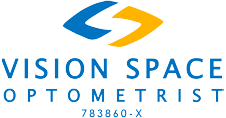In recent years, the prevalence of childhood myopia, commonly known as nearsightedness, has been on a significant rise among children across the globe. This condition, where distant objects appear blurry while close ones are seen clearly, is not just a minor inconvenience; it’s becoming a major public health concern. Studies have shown that progressive myopia is more than just a refractive error; it can lead to severe visual impairment and even blindness due to complications such as retinal detachment, macular degeneration, and glaucoma if left uncorrected or untreated [1][2][3]. The global potential productivity loss attributed to uncorrected myopia is estimated at a staggering US$244 billion, underscoring the economic as well as the personal impact of this condition[1]. If you notice early signs of blurred distance vision in your child, such as squinting, headaches, or difficulty seeing distant objects, it’s crucial to take action. If you have concerns or notice any symptoms, consulting with an eye care professional can ensure timely intervention and management.
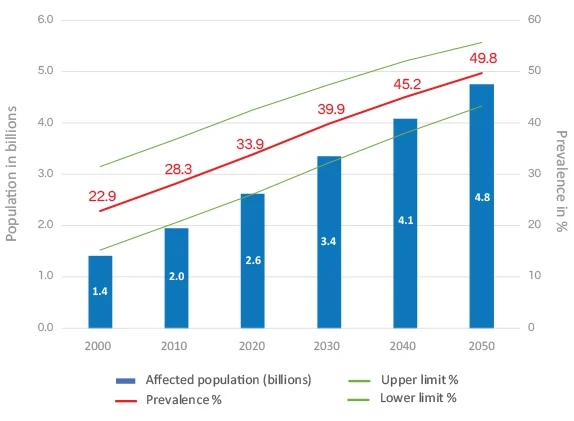
Given the increasing prevalence of myopia, especially among younger populations in various regions including East Asia, Southeast Asia, and even parts of Africa and Brazil, there’s a pressing need for effective management strategies [1][2][3].
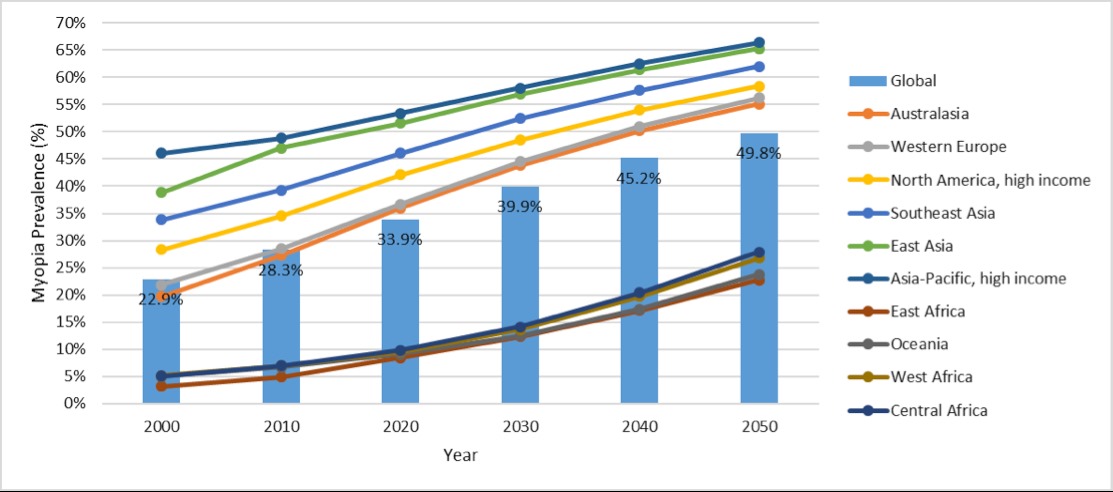
Myopia management represents a proactive approach aimed at not just correcting the blurred vision but also at slowing down the progression of myopia in young children. This approach encompasses a variety of strategies, including the use of prescription eyewear, contact lenses specifically designed for myopia control, pharmaceutical interventions like low-dose atropine eye drops, and lifestyle modifications such as increasing outdoor activities [4][5][6]. The goal of myopia management is to mitigate the progression of myopia during the critical growth years of a child’s life, thereby reducing the risk of developing high myopia and its associated complications. This proactive approach is not only about safeguarding the child’s current vision but also about ensuring their visual health in the long term.
What is Myopia?
Myopia, commonly known as nearsightedness, is a refractive error where the eye grows too long from front to back, causing light rays to focus at a point in front of the retina rather than directly on its surface. This results in distant objects appearing blurry while close objects can be seen clearly [8]. Myopia is not just a simple inconvenience; Its progression can lead to significant vision problems [8].
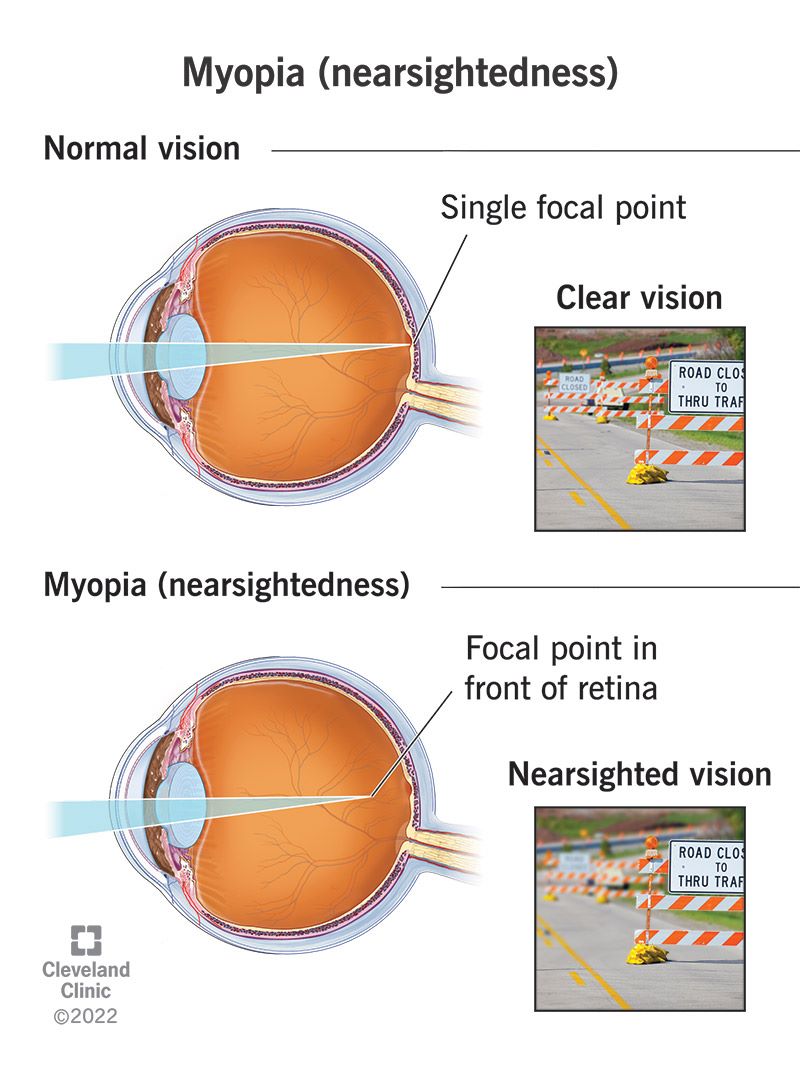
The risks associated with the progression of myopia are substantial. As myopia worsens, it can lead to high myopia, which is associated with a greater likelihood of developing serious ocular diseases. These include cataracts, glaucoma, and retinal detachment, all of which can lead to vision impairment or even blindness [7][9]. Moreover, pathologic myopia, characterized by excessive elongation of the eye and changes in the fundus, can predict other diseases of the eye structures and is a threat to central vision [9].
Children with myopia require careful monitoring and management to correct myopia and control its progression. The increasing prevalence of myopia has been described as reaching epidemic proportions, making it a major economic health burden [7]. It is crucial to understand that myopia is not a benign condition and should be addressed with appropriate interventions to mitigate the risks associated with its progression [8].
Why Early Intervention Matters
Detecting myopia, or nearsightedness, early in children is crucial for several reasons. Myopia is not just about needing glasses to see distant objects clearly; it’s a condition that can progress, leading to high levels of myopia which are associated with a greater risk of serious eye diseases later in life. Early detection and intervention can significantly alter the course of myopia, reducing the risk of it developing into high myopia and thereby decreasing the likelihood of associated eye diseases.
The Importance of Detecting Myopia Early
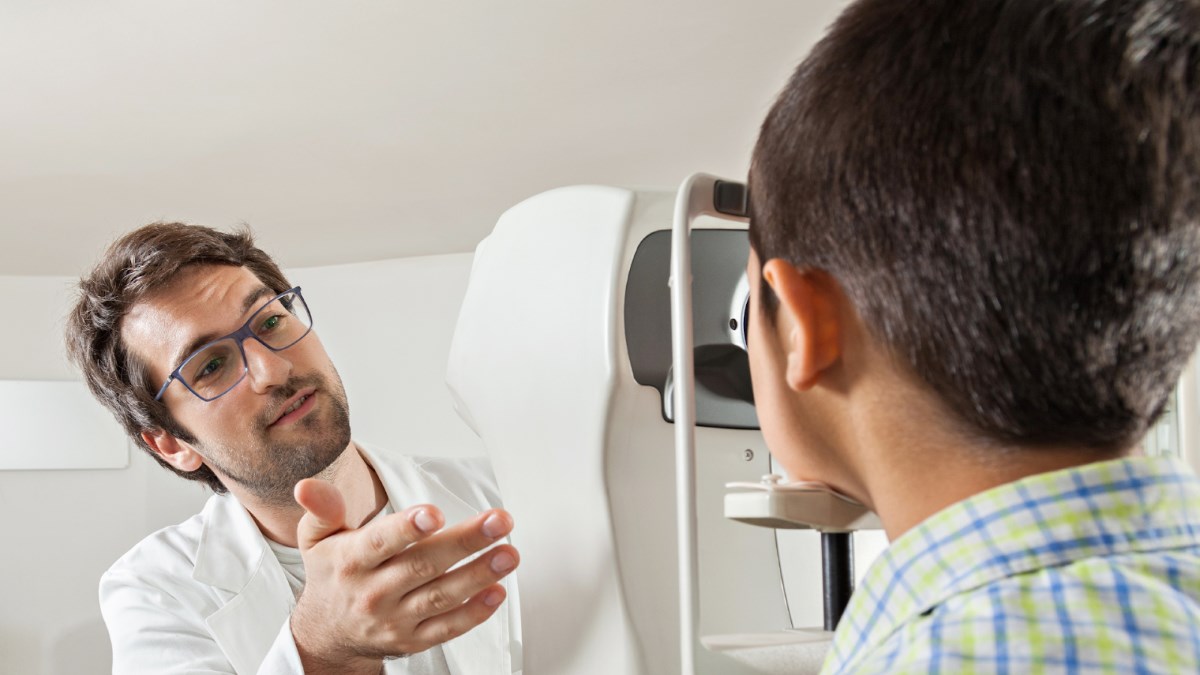
Myopia typically begins in childhood and can progress rapidly as the child grows. The earlier myopia is detected, the sooner intervention can begin to slow its progression. Studies have shown that myopia progresses more quickly in younger children, which means that early detection is key to preventing high levels of myopia [14]. Furthermore, early intervention can help address the psycho-social impacts of myopia, such as the potential for reduced academic performance and social stigma associated with wearing glasses [11].
Benefits of Early Intervention
The primary benefit of early intervention for myopia is the potential to prevent high levels of myopia. High myopia significantly increases the risk of developing serious eye conditions such as retinal detachment, glaucoma, and myopic maculopathy, which can lead to vision loss or blindness [10][13]. By detecting and managing myopia early, the progression to high levels of myopia can be slowed, thereby reducing the risk of these associated eye diseases.
Moreover, early intervention can improve the quality of life for children with myopia. With appropriate management strategies, such as prescription eyeglasses, contact lenses, or pharmacological treatments like low-dose atropine, children can enjoy better visual acuity. This not only enhances their ability to learn and participate in activities but also reduces the risk of developing amblyopia (“lazy eye”), a condition that can result from uncorrected myopia [12].
In conclusion, early detection and intervention of myopia in children are paramount. They not only prevent the progression to high levels of myopia but also significantly reduce the risk of developing serious eye diseases associated with high myopia. Furthermore, early intervention supports children’s overall development, academic performance, and quality of life by ensuring they have the best possible vision during their critical growing years.
Everything About Myopia Control
Myopia control or management is a proactive approach aimed at slowing the progression of myopia in young individuals. The purpose of myopia management is not only to improve current vision but also to reduce the risk of developing associated eye diseases later in life, such as retinal detachment, glaucoma, and myopic maculopathy.
Components of Myopia Management Programs Including the Cornea
Myopia management programs consist of various strategies and treatments tailored to the individual needs of the child. These components include:
- Optical Interventions: This involves the use of specially designed eyeglasses and contact lenses that can help control the elongation of the eye, which is a key factor in myopia progression. Traditional single-vision spectacle lenses are commonly prescribed to correct myopia, but they do not slow its progression. In contrast, myopia controlling spectacle lenses with lenslets or diffusion technology such as DIMS Technology (Hoya MiYOSMART), H.A.L.T. Technology (Essilor Stellest), Cylindrical Annular Refractive Elements (C.A.R.E.) technology, bifocal and multifocal lenses, and orthokeratology lenses, which are worn overnight to temporarily reshape the cornea [15][18].
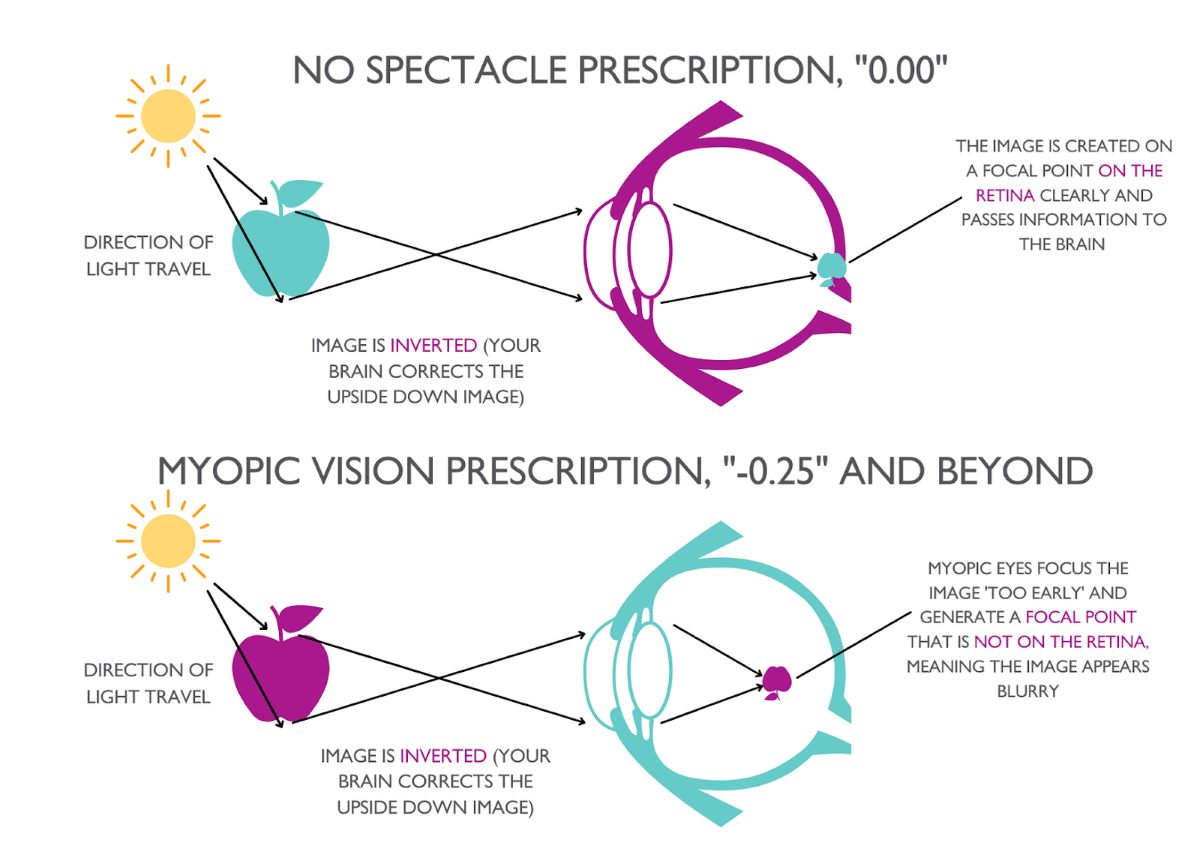
- Pharmacological Treatments: Low-dose atropine eye drops have been shown to slow down the progression of myopia in children. These drops are used once daily and have been a focus of numerous studies, demonstrating effectiveness in controlling myopia [19].
- Lifestyle Modifications: Encouraging children to spend more time outdoors has been associated with a reduced risk of developing myopia. Outdoor activities expose the eyes to natural light and reduce the time spent on near work activities, such as reading and screen time, which can contribute to myopia progression [16][17].
- Regular Monitoring: Frequent eye examinations are crucial to monitor the progression of myopia and adjust treatment plans as necessary. This ensures that the management strategies remain effective over time [18].
To safeguard the health of your eyes and ensure the effectiveness of myopia management strategies, it’s essential to undergo regular monitoring and eye examinations.
In conclusion, myopia management is a comprehensive approach that combines various strategies to slow the progression of myopia in children. By addressing the condition early, parents can play a crucial role in protecting their child’s vision and reducing the risk of future eye health issues.
Options for Myopia Management with Glasses or Contact Lenses in Young Children
Special Spectacle Lenses
In the realm of myopia management for young children, innovative spectacle lens designs have emerged as a promising solution. Among these, Dual Focus (DF) and Highly Aspherical Lenslets (HAL) lenses stand out for their unique approach to slowing down the progression of myopia.
- Dual Focus Lenses are designed with a central optical zone for correcting distance vision, surrounded by multiple focus zones that help in managing myopia by providing a myopic defocus. This myopic defocus acts as a signal to slow down the eye growth, which is a key factor in myopia progression.
- Highly Aspherical Lenslets (HAL), on the other hand, incorporate lenslets with a high degree of asphericity in the peripheral zones of the lens. These lenslets create a myopic defocus across the retina, which is believed to reduce the stimulus for the eye to grow longer, thereby controlling myopia progression.
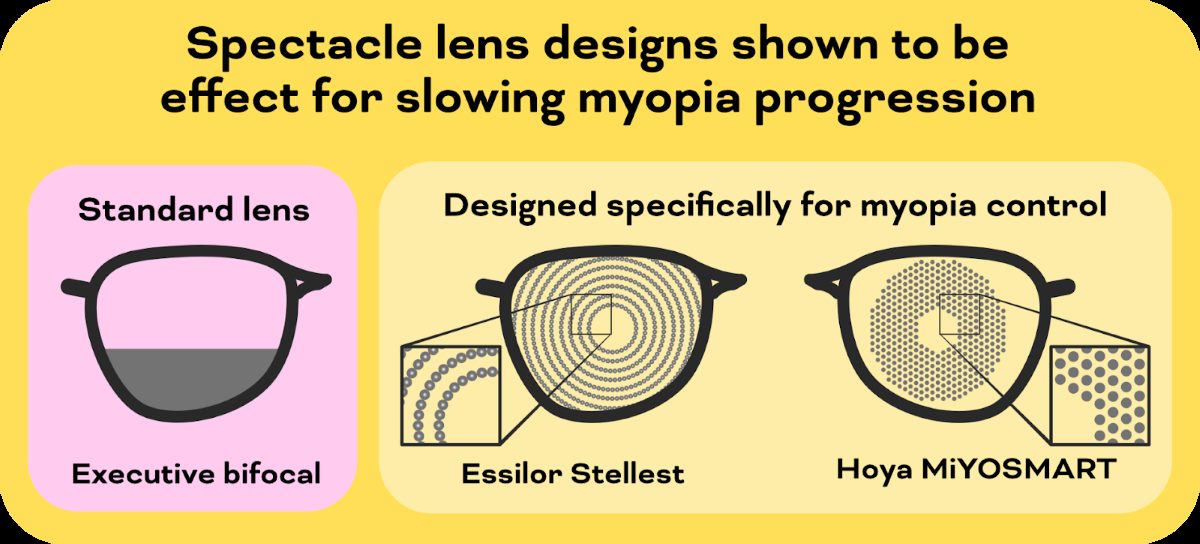
Evidence supporting the effectiveness of these innovative lens designs is compelling. Studies have shown that HAL lenses can significantly slow down myopia progression and axial elongation in children. For instance, children wearing HAL lenses experienced a 67% reduction in myopia progression compared to those wearing single-vision lenses over a period of one year [21]. Similarly, Dual Focus lenses have demonstrated effectiveness in controlling myopia, with research indicating a substantial reduction in the progression of myopia in children using these lenses [22].
Contact Lenses for Myopia Control
Orthokeratology (OK) Lenses, Extended Depth of Focus (EDOF) Lenses and MiSight 1 Day contact Lenses represent three advanced contact lens technologies for myopia control.
- Orthokeratology (OK) Lenses are specially designed rigid gas-permeable contact lenses that temporarily reshape the cornea during sleep. Upon waking, the child removes the lenses and can enjoy clear vision throughout the day without the need for glasses or contact lenses. The reshaping effect on the cornea also aims to slow the progression of myopia by altering the way light rays focus on the retina. A study assessing the clinical effectiveness of OK lenses found that they had a refractive myopia progression control rate of 78.5% compared to spectacle wearers after one year of treatment [20].
- Extended Depth of Focus (EDOF) Lenses are soft contact lenses designed to extend the range of clear vision by creating a gradient of power across the lens. This design aims to slow myopia progression by providing a consistent myopic defocus across the retina. Research on the efficacy of soft contact lenses for myopia control has shown that they are effective in slowing down myopia progression, offering a good quality of vision and having a positive impact on accommodative and binocular functions [23].
- MiSight 1 Day contact Lenses are a revolutionary daily disposable lens designed specifically for myopia control in children. They utilize ActivControl Technology, which creates a dual-focus optical design that focuses light in front of the retina, slowing the progression of myopia. The lenses have a concentric ring design with two correction zones for myopia correction and two treatment zones that create a peripheral “myopic defocus.” This defocus is believed to slow the elongation of the eye, the primary cause of myopia. The lenses are FDA-approved and have been shown to be effective in slowing the progression of myopia in children, with a 52% average reduction in eye elongation in a three-year clinical trial [24][25].
In conclusion, both innovative spectacle lenses and contact lenses offer promising options for managing myopia in young children. The evidence from various studies underscores their potential in slowing down the progression of myopia, thereby protecting children’s vision from the adverse effects associated with high levels of myopia.
Long-Term Effects and Safety of Myopia Management
Myopia management in young children is crucial for preventing the progression to high myopia and associated sight-threatening conditions. Here, we explore the long-term benefits and safety of various myopia management options for young children.
Long-Term Benefits
The primary goal of myopia management is to slow down the progression of myopia, thereby reducing the risk of developing high myopia. High myopia is associated with a greater risk of serious eye conditions such as myopic maculopathy, retinal detachment, and glaucoma. Research has shown that controlling myopia progression by at least one diopter during childhood can significantly reduce the risk of developing myopic maculopathy by 40% [27]. This highlights the importance of early intervention.
Orthokeratology (Ortho-K), low-dose atropine eye drops, and multifocal contact lenses are among the most effective myopia management strategies. Ortho-K lenses are worn overnight to temporarily reshape the cornea, reducing myopia during the day. This method has been shown to slow axial growth, a key factor in myopia progression [26]. Low-dose atropine eye drops have been recognized as the best pharmacological option, proving to be safe, effective, and showing the least rebound effect with negligible side effects[1]. Multifocal contact lenses, designed to create a peripheral myopic defocus, have also been effective in slowing myopia progression [26][28].
Safety Concerns
When it comes to young children, safety is a paramount concern for parents considering myopia management options. The good news is that the current myopia management strategies have been extensively studied and are generally considered safe for children.
While Ortho-K has been found to be effective for vision correction and myopia control, it is not without risk as with any contact lens wear. Nevertheless, these risks are minimal and can be efficiently mitigated by adhering to scheduled follow-up appointments, maintaining strict compliance with cleaning routines, and using suitable solutions to safeguard the wearer’s well-being. Low-dose atropine eye drops have been extensively studied and are deemed safe for children, with minimal side effects such as slight mydriasis (dilation of the pupil) and a reduced amplitude of accommodation, which are generally well tolerated [26][28]. Multifocal contact lenses are also safe for children, with studies indicating that children benefit from wearing contact lenses not only for myopia control but also for improved self-esteem and quality of life [26].
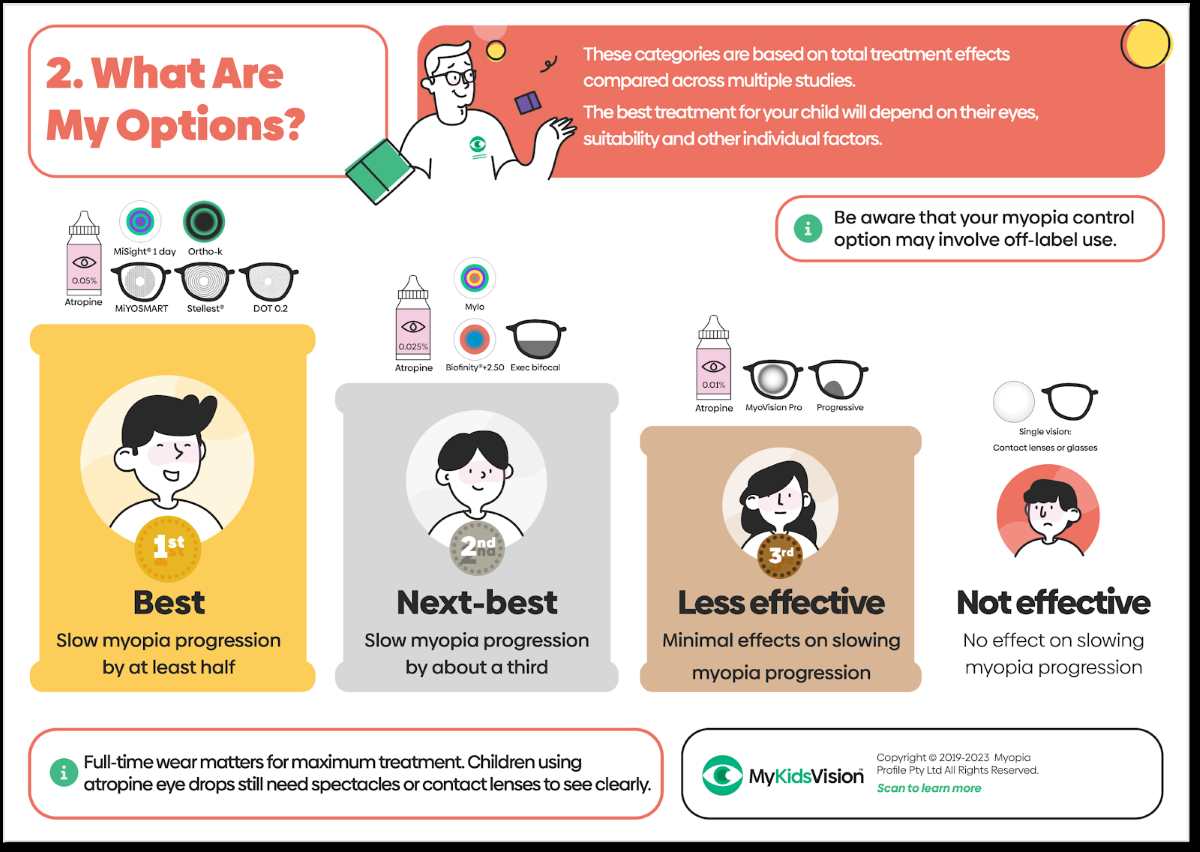
In conclusion, myopia management strategies such as Ortho-K, low-dose atropine eye drops, and multifocal contact lenses offer significant long-term benefits in preventing the progression to severe myopia and reducing the risk of associated eye diseases. While safety concerns are natural, the evidence supports the safety and efficacy of these options for young children, making them viable strategies for protecting your child’s vision.
When to Consider Myopia Management for Your Child
As parents, it’s crucial to recognize the early signs of myopia in your child to manage the condition effectively and prevent its progression. Here are some signs that may indicate your child is developing myopia and the steps you should take.
Signs Your Child May Be Developing Myopia
- Squinting: If your child squints frequently while trying to focus on distant objects, it could be a sign that they are struggling with nearsightedness.
- Sitting Closer to the TV or Screen: A preference for sitting closer to the television or holding handheld devices very close to their eyes can indicate difficulty seeing from a distance.
- Excessive Eye Rubbing: While there can be various reasons for eye rubbing, doing so excessively might suggest eye strain from attempting to focus, which is common in myopic children.
- Complaints of Headaches: Frequent headaches, especially after reading, watching TV, or using a computer, can be a symptom of eye strain associated with myopia.
- Poor Academic Performance: If your child suddenly seems to struggle with schoolwork, particularly activities that involve seeing the board from a distance, it might be due to uncorrected vision problems.
Steps to Take
- Observe and Note Symptoms: Keep a record of the signs and symptoms you’ve noticed in your child. This information can be valuable during an eye examination.
- Schedule a Comprehensive Eye Examination: Early detection is key to managing myopia effectively. Schedule a comprehensive eye examination with a trained optometrist or ophthalmologist. Unlike basic vision screenings, a comprehensive eye exam will assess your child’s overall eye health and accurately diagnose myopia [29][30]. It’s crucial to prioritize the health of your eyes by undergoing comprehensive eye examinations to accurately assess and diagnose conditions like myopia.
- Discuss Myopia Management Options: If your child is diagnosed with myopia, discuss management options with your eye care professional. There are several strategies to slow the progression of myopia, including prescription eyeglasses or contact lenses, orthokeratology (Ortho-K), and atropine eye drops [29].
- Follow-up Care: Regular follow-up appointments are essential to monitor your child’s vision and adjust their myopia management plan as needed. These appointments allow the optometrist to track the progression of myopia and make any necessary changes to the treatment strategy.
By recognizing the early signs of myopia and taking proactive steps, you can help protect your child’s vision and reduce the risk of its progression. Early intervention through comprehensive eye examinations and appropriate myopia management strategies can make a significant difference in your child’s visual health and overall well-being.
Finding the Right Solution for Your Child
When it comes to safeguarding your child’s vision against myopia, consulting with optometry professionals who specialize in myopia management is a critical first step. These specialists are equipped with the knowledge and tools to assess your child’s specific needs and recommend the most effective treatment plan. Here are ten key considerations for parents when choosing the best myopia management strategy for their child:
- Child’s Age and Maturity: Consider your child’s age and level of maturity, as some treatments require a higher level of responsibility, such as the care and maintenance of contact lenses [31].
- Degree of Myopia: The current degree of myopia and the rate of its progression are important factors in determining the urgency and type of intervention required [32].
- Lifestyle Factors: Take into account your child’s daily activities, including outdoor play and screen time, as these can influence the choice of myopia management [32].
- Treatment Efficacy: Research the efficacy of various treatments, such as Ortho-K lenses, atropine eye drops, and multifocal lenses, and their success rates in slowing myopia progression [31][32].
- Safety and Side Effects: Understand the potential risks and side effects associated with different myopia management options to ensure the safety of your child [31][33].
- Long-Term Management: Consider the long-term commitment required for different treatments, including regular follow-ups and potential adjustments to the management plan [32].
- Cost and Accessibility: Evaluate the cost of treatment options and their availability in your area, as some may require more frequent visits to a specialist or higher initial investment [31].
- Child’s Comfort and Preferences: Take into account your child’s comfort with different treatment options, as their willingness to comply can significantly impact the effectiveness of the management strategy [31].
- Family History: A family history of high myopia may influence the choice of treatment, as children with a genetic predisposition may require more aggressive management [32].
- Expert Recommendations: Rely on the expertise of myopia management professionals who can provide personalized recommendations based on the latest research and clinical guidelines [32].
By carefully considering these factors and maintaining open communication with a myopia management specialist, you can make an informed decision that aligns with your child’s unique needs and maximizes their chances of maintaining healthy vision.
Conclusion
Protecting your child’s vision through proactive myopia management is not just important – it’s essential. The progression of myopia not only affects your child’s ability to see the world clearly but also increases their risk of developing serious eye diseases later in life. By understanding the significance of myopia and its potential complications, parents can take a crucial step towards safeguarding their child’s vision health.
Early intervention is key. The sooner myopia management strategies are implemented, the better the chances of slowing down the progression of myopia and reducing the risk of future eye problems. This can include regular eye examinations, lifestyle adjustments, and possibly the use of specific optical or pharmacological treatments designed to control myopia.
Don’t wait to protect your child’s vision. Schedule a myopia screening for your child as soon as possible. Early detection is a critical step in managing myopia and maintaining your child’s eye health. Consult with eye care professionals who specialize in pediatric vision care to discuss myopia management options tailored to your child’s needs. By taking action now, you can help set the foundation for a lifetime of better vision for your child.
References:
-
[1] Dhivyaa, T., et al. “The Prevalence of Myopia Among School-Going Children (6-14 Years) in Chidambaram, Tamil Nadu: A Cross-Sectional Study.” (2021). Semantic Scholar, www.semanticscholar.org/paper/ea8ad2c327d45df98c882106d1e3dd4c7b2ab9ad. Accessed 17 Apr. 2024.
-
[2] Akinbinu, Tope R., et al. “Myopia Prevalence in School-Aged Children in Garki District of Abuja, Nigeria.” African Vision and Eye Health (2022): n. pag. Semantic Scholar, www.semanticscholar.org/paper/255fe04a283fc4b59aa2a012056500ae10871777. Accessed 17 Apr. 2024.
-
[3] Yotsukura, Erisa, et al. “Axial Length and Prevalence of Myopia among Schoolchildren in the Equatorial Region of Brazil.” Journal of Clinical Medicine, vol. 10, no. 1, 2021, Article 115, doi:10.3390/jcm10010115. PubMed Central (PMC), www.ncbi.nlm.nih.gov/pmc/articles/PMC7794886/. Accessed 17 Apr. 2024.
-
[4] International Myopia Institute Ambassador Group*. “IMI—Global Trends in Myopia Management Attitudes and Strategies in Clinical Practice—2022 Update.” Investigative Ophthalmology & Visual Science, vol. 64, no. 6, 2023, Article PMC10155870, doi:10.1167/iovs.64.6.6. PubMed Central (PMC), www.ncbi.nlm.nih.gov/pmc/articles/PMC10155870/. Accessed 17 Apr. 2024.
-
[5] Saw, Seang-Mei, Saiko Matsumura, and Quan V. Hoang. “Prevention and Management of Myopia and Myopic Pathology.” Investigative Ophthalmology & Visual Science, vol. 60, no. 2, 2019, pp. 488-499, doi:10.1167/iovs.18-25221. PubMed, www.pubmed.ncbi.nlm.nih.gov/30707221/. Accessed 17 Apr. 2024.
-
[6] “IMPACT Myopia Management Guidelines.” Indian Journal of Ophthalmology, vol. 71, no. 7, 2023, pp. 2882–2884. PubMed Central (PMC), www.ncbi.nlm.nih.gov/pmc/articles/PMC10491045/. Accessed 17 Apr. 2024.
-
[7] Lipson, Michael J., and Gary Sandall. “Myopia Control: Science or Luck.” Eye Contact Lens, vol. 42, no. 1, Jan. 2016, pp. 80-81, doi:10.1097/ICL.0000000000000172. PubMed, www.pubmed.ncbi.nlm.nih.gov/26704139/. Accessed 17 Apr. 2024.
-
[8] Tarrant, Janice M. “Spherical Aberration, Accommodation and Myopia.” (2010). Semantic Scholar, www.semanticscholar.org/paper/93dd9e478dc2b7a3bc3c967bb941b887c1bb294a. Accessed 17 Apr. 2024.
-
[9] Sadykova, Ravilya Ravilievna, et al. “Diseases of the Eyeball Associated with Pathologic Myopia.” Reflection (2022): n. pag. Semantic Scholar, www.semanticscholar.org/paper/e7ace4e8cd60545f5d7ff4b25151bf32bbce29d8. Accessed 17 Apr. 2024.
-
[10] Romín, Daniel Monsálvez, et al. “Global Prevalence of Hyperopia.” (2015). Semantic Scholar, www.semanticscholar.org/paper/3066e1f3c4863ca17b8fa18894a739edb2933292. Accessed 17 Apr. 2024.
-
[11] Vincent, Stephen J. “The Use of Contact Lenses in Low Vision Rehabilitation: Optical and Therapeutic Applications.” Clin Exp Optom, vol. 100, no. 5, Sept. 2017, pp. 513-521, doi:10.1111/cxo.12562. PubMed, www.pubmed.ncbi.nlm.nih.gov/28664572/. Accessed 17 Apr. 2024.
-
[12] Marta Alvarez, et al. “Early Detection of Refractive Errors by Photorefraction at School Age.” International Journal of Environmental Research and Public Health, vol. 19, no. 23, 2022, Article 15880, doi:10.3390/ijerph192315880. PubMed Central (PMC), www.ncbi.nlm.nih.gov/pmc/articles/PMC9739333/. Accessed 17 Apr. 2024.
-
[13] Ahmed, A S M Nawshad Uddin, et al. “Retinopathy of Prematurity in Bangladeshi Neonates.” Journal of Tropical Pediatrics, vol. 54, no. 5, Oct. 2008, pp. 333-339, doi:10.1093/tropej/fmn035. PubMed, www.pubmed.ncbi.nlm.nih.gov/18503093/. Accessed 17 Apr. 2024.
-
[14] Leo, Seo Wei, and the Scientific Bureau of World Society of Paediatric Ophthalmology and Strabismus (WSPOS). “Current Approaches to Myopia Control.” Current Opinion in Ophthalmology, vol. 28, no. 3, May 2017, pp. 267-275, doi:10.1097/ICU.0000000000000367. PubMed, www.pubmed.ncbi.nlm.nih.gov/28212157/. Accessed 17 Apr. 2024.
-
[15] Signes-Soler, Isabel, et al. “Visual Performance of Two Designs of Myopia Management Soft Contact Lenses Compared with a Monofocal One in Young Adults.” Journal of Ophthalmic & Vision Research, vol. 18, no. 4, 2023, pp. 359-368. PubMed Central (PMC), doi:10.18502/jovr.v18i4.14544, www.ncbi.nlm.nih.gov/pmc/articles/PMC10794806/. Accessed 17 Apr. 2024.
-
[16] Gilmartin, Bernard. “Myopia: Pathways to Therapy.” Optometry and Vision Science, vol. 81, no. 1, Jan. 2004, pp. 1-3, doi:10.1097/00006324-200401000-00001. PubMed, www.pubmed.ncbi.nlm.nih.gov/14747753/. Accessed 17 Apr. 2024.
-
[17] Fashner, Julia. “Eye Conditions in Infants and Children: Myopia and Hyperopia.” FP Essent, vol. 2019, no. 484, Sept. 2019, pp. 23-27. PubMed, www.pubmed.ncbi.nlm.nih.gov/31454214/. Accessed 17 Apr. 2024.
-
[18] Wolffsohn, James S., et al. “IMI-Global Trends in Myopia Management Attitudes and Strategies in Clinical Practice-2022 Update.” Investigative Ophthalmology & Visual Science, vol. 64, no. 6, 2023, p. 6, doi:10.1167/iovs.64.6.6. PubMed Central (PMC), www.ncbi.nlm.nih.gov/pmc/articles/PMC10155870/. Accessed 17 Apr. 2024.
-
[19] Lanca, Carla, Michael X. Repka, and Andrzej Grzybowski. “Topical Review: Studies on Management of Myopia Progression from 2019 to 2021.” Optometry and Vision Science, vol. 100, no. 1, Jan. 2023, pp. 23-30, doi:10.1097/OPX.0000000000001947. PubMed, www.pubmed.ncbi.nlm.nih.gov/36705712/. Accessed 17 Apr. 2024.
-
[20] Queirós, António, et al. “Assessment of the Clinical Effectiveness of DRL Orthokeratology Lenses vs. Single-Vision Spectacles in Controlling the Progression of Myopia in Children and Teenagers: 2 Year Retrospective Study.” Children (Basel, Switzerland), vol. 10, no. 2, 2023, Article 402, doi:10.3390/children10020402. PubMed Central (PMC), www.ncbi.nlm.nih.gov/pmc/articles/PMC9955086/. Accessed 17 Apr. 2024.
-
[21] Bao, Jinhua, et al. “One-Year Myopia Control Efficacy of Spectacle Lenses with Aspherical Lenslets.” BMJ Open Access, vol. 106, no. 8, 2022, pp. 1171–1176, doi:10.1136/bjophthalmol-2020-318367. PubMed Central (PMC), www.ncbi.nlm.nih.gov/pmc/articles/PMC9340037/. Accessed 17 Apr. 2024.
-
[22] Lupon, Marta, Carme Nolla, and Genis Cardona. “New Designs of Spectacle Lenses for the Control of Myopia Progression: A Scoping Review.” Journal of Clinical Medicine, vol. 13, no. 4, 2024, Article 1157, doi:10.3390/jcm13041157. PubMed Central (PMC), www.ncbi.nlm.nih.gov/pmc/articles/PMC10888677/. Accessed 17 Apr. 2024.
-
[23] Corpus, Gema, Ainhoa Molina-Martin, and David P. Piñero. “Efficacy of Soft Contact Lenses for Myopia Control: A Systematic Review.” Seminars in Ophthalmology, vol. 39, no. 3, Apr. 2024, pp. 185-192, doi:10.1080/08820538.2023.2271063. PubMed, www.pubmed.ncbi.nlm.nih.gov/37853677/. Accessed 17 Apr. 2024.
-
[24] Gifford, Kate. “Mastering MiSight 1 Day.” Myopia Profile, 4 June 2021, www.myopiaprofile.com/articles/mastering-misight. Accessed 8 June 2024.
-
[25] Boshnick, Edward. “The Future of Myopia Treatment: An In-Depth Look at MiSight 1 Day Contact Lenses.” Eye Freedom, 13 July 2023, eyefreedom.com/misight-1-day-contact-lenses-myopia-treatment/. Accessed 8 June 2024.
-
[26] Heide, A. “Fitting Soft Multifocal Customized Contact Lenses for Myopia Control: A Literature Review.” (2019). Semantic Scholar, www.semanticscholar.org/paper/f880a001e56de1264ab0f939e835926f00cd5d39. Accessed 17 Apr. 2024.
-
[27] Verkicharla, Pavan K., et al. “The ‘IMPACT’ Myopia Management Guidelines.” Indian Journal of Ophthalmology, vol. 71, no. 7, 2023, pp. 2882–2884. PubMed Central (PMC), www.ncbi.nlm.nih.gov/pmc/articles/PMC10491045/. Accessed 17 Apr. 2024.
-
[28] Jonas, Jost B., et al. “IMI Prevention of Myopia and Its Progression.” Investigative Ophthalmology & Visual Science, vol. 62, no. 5, 2021, Article PMC8083117, doi:10.1167/iovs.62.5.6. PubMed Central (PMC), www.ncbi.nlm.nih.gov/pmc/articles/PMC8083117/. Accessed 17 Apr. 2024.
-
[29] Jones, Deborah A., et al. “Eye See Eye Learn: The Benefit of Comprehensive Eye Examinations for Preschoolers.” (2012). Semantic Scholar, www.semanticscholar.org/paper/065cbb38a4efd4066eeb90cb078547bb78c2ecf9. Accessed 17 Apr. 2024.
-
[30] Coulter, Rachel Anastasia, et al. “Near-point Findings in Children with Autism Spectrum Disorder and in Typical Peers.” Optometry and Vision Science, vol. 98, no. 4, 2021, pp. 384–393. PubMed Central (PMC), doi:10.1097/OPX.0000000000001679, www.ncbi.nlm.nih.gov/pmc/articles/PMC8051934/. Accessed 17 Apr. 2024.
-
[31] Di Pierdomenico, Johnny, et al. “Attitudes and Knowledge of Myopia Management by Spanish Optometrists.” International Ophthalmology, vol. 43, no. 11, 2023, pp. 4247-4261, doi:10.1007/s10792-023-02835-7. PubMed Central (PMC), www.ncbi.nlm.nih.gov/pmc/articles/PMC10520101/. Accessed 17 Apr. 2024.
-
[32] Tapasztó, Beáta, et al. “Myopia Management Algorithm. Annexe to the Article Titled Update and Guidance on Management of Myopia. European Society of Ophthalmology in Cooperation with International Myopia Institute.” European Journal of Ophthalmology, Dec. 2023, doi:10.1177/11206721231219532. PubMed, www.pubmed.ncbi.nlm.nih.gov/38087768/. Accessed 17 Apr. 2024.
-
[33] Gilmartin, Bernard. “Myopia: Pathways to Therapy.” Optometry and Vision Science, vol. 81, no. 1, Jan. 2004, pp. 1-3, doi:10.1097/00006324-200401000-00001. PubMed, www.pubmed.ncbi.nlm.nih.gov/14747753/. Accessed 17 Apr. 2024.
This Article is Medically Reviewed by Woon Pak Seong

Woon graduated as an optometrist in 1995. After working for 9 years for a chain store and an individual optometry practice, he started Vision Space in 2004 to bring the best in global practices of vision care to customers.
He believes in the principle of continuous improvement and excellence. He enjoys meeting people and encouraging them to enjoy life.
A believer in lifelong learning, Woon loves to give optical training and talks at conferences and fairs. He takes delight in reading journals, magazines and books on how to serve his customers better as well as improving the practice of optometry.
His passion is to help people see clearly, comfortably and maintain good eye health through screening for potential eye diseases.
His specialties include:
1. Solving complex vision problems to help customers see clearly.
2. Helping children slow down their shortsightedness.
3. Fitting special multifocal spectacle lenses.
A fun fact about Mr. Woon: He is a movie buff and enjoys good music and food.
Favourite Quote: “Live life to the fullest.”
